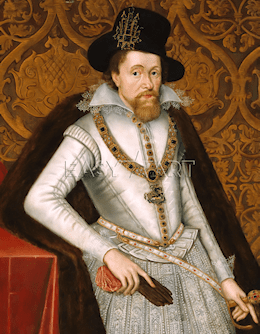Textus Receptus Bibles
King James Bible 1611
| 24:1 | And the Lord spake vnto Moses, saying, |
| 24:2 | Command the children of Israel, that they bring vnto thee pure oyle Oliue, beaten, for the light, to cause the lampes to burne continually. |
| 24:3 | Without the Uaile of the Testimonie, in the Tabernacle of the Congregation, shal Aaron order it from the euening vnto the morning, before the Lord continually: It shall be a Statute for euer in your generations. |
| 24:4 | He shall order the lampes vpon the pure Candlesticke before the Lord continually. |
| 24:5 | And thou shalt take fine flowre, and bake twelue cakes thereof: two tenth deales shall be in one cake. |
| 24:6 | And thou shalt set them in two rowes, sixe on a row vpon the pure Table, before the Lord. |
| 24:7 | And thou shalt put pure frankincense vpon ech row, that it may bee on the bread for a memorial, euen an offering made by fire vnto the Lord. |
| 24:8 | Euery Sabbath he shall set it in order before the Lord continually, being taken from the children of Israel by an euerlasting couenant. |
| 24:9 | And it shall be Aarons and his sonnes, and they shall eate it in the holy place: for it is most holy vnto him, of the offerings of the Lord made by fire, by a perpetuall statute. |
| 24:10 | And the sonne of an Israelitish woman, whose father was an Egyptian, went out among the children of Israel: and this sonne of the Israelitish woman, and a man of Israel stroue together in the campe. |
| 24:11 | And the Israelitish womans sonne blasphemed the name of the Lord, and cursed, and they brought him vnto Moses: and his mothers name was Shelomith, the daughter of Dibri, of the tribe of Dan. |
| 24:12 | And they put him in ward, that the minde of the Lord might bee shewed them. |
| 24:13 | And the Lord spake vnto Moses, saying, |
| 24:14 | Bring forth him that hath cursed, without the Campe, and let all that heard him, lay their hands vpon his head, and let all the Congregation stone him. |
| 24:15 | And thou shalt speake vnto the children of Israel, saying, Whosoeuer curseth his God, shall beare his sinne. |
| 24:16 | And hee that blasphemeth the Name of the Lord, he shall surely be put to death, and all the Congregation shall certainely stone him: Aswell the stranger, as he that is borne in the land, when he blasphemeth the Name of the Lord, shall be put to death. |
| 24:17 | And he that killeth any man, shall surely be put to death. |
| 24:18 | And he that killeth a beast, shall make it good; beast for beast. |
| 24:19 | And if a man cause a blemish in his neighbour; as he hath done, so shal it be done to him: |
| 24:20 | Breach, for breach, eye for eye, tooth for tooth: as he hath caused a blemish in a man, so shall it be done to him againe. |
| 24:21 | And hee that killeth a beast, hee shall restore it: and hee that killeth a man, he shall be put to death. |
| 24:22 | Ye shall haue one maner of law, aswell for the stranger, as for one of your owne countrey: for I am the Lord your God. |
| 24:23 | And Moses spake to the children of Israel, that they should bring foorth him that had cursed, out of the Campe, and stone him with stones: and the children of Israel did as the Lord commanded Moses. |

King James Bible 1611
The commissioning of the King James Bible took place at a conference at the Hampton Court Palace in London England in 1604. When King James came to the throne he wanted unity and stability in the church and state, but was well aware that the diversity of his constituents had to be considered. There were the Papists who longed for the English church to return to the Roman Catholic fold and the Latin Vulgate. There were Puritans, loyal to the crown but wanting even more distance from Rome. The Puritans used the Geneva Bible which contained footnotes that the king regarded as seditious. The Traditionalists made up of Bishops of the Anglican Church wanted to retain the Bishops Bible.
The king commissioned a new English translation to be made by over fifty scholars representing the Puritans and Traditionalists. They took into consideration: the Tyndale New Testament, the Matthews Bible, the Great Bible and the Geneva Bible. The great revision of the Bible had begun. From 1605 to 1606 the scholars engaged in private research. From 1607 to 1609 the work was assembled. In 1610 the work went to press, and in 1611 the first of the huge (16 inch tall) pulpit folios known today as "The 1611 King James Bible" came off the printing press.